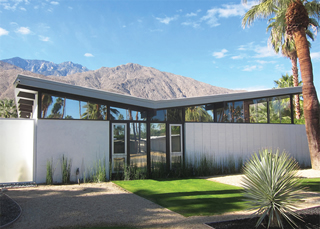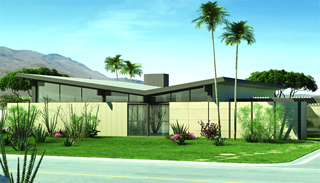Return of the Butterflies - Page 4
 |
 |
|
|
Both the Swiss architect Le Corbusier and the American Frank Lloyd Wright, working independently in the late 1920s, came up with designs for butterfly-roofed homes that would seem at home in Palm Springs today.
Drawings in graphite and colored pencil for Wright’s ‘Type A Butterfly Roof,’ dating to “between 1920 and 1930,” according to the Library of Congress, can be found in the library’s collection.
The drawings were reproduced in a French magazine in 1930—too late to have influenced Corbusier, whose Casa Errazuriz, a two-story home with a classic butterfly profile, was designed for an ocean-side site in Chile in 1929.
Neither home was built.
Maybe the Depression intervened, or World War II. But the chrysalises were ready to open. In 1943, Oscar Niemeyer, a founder of the Modern Movement, created the stylish, two-story, butterfly-roofed Kubitschek home in Minas Gerais, Brazil, one of the first, if not the very first, true butterfly-roofed modern homes to be built.
Just as the war was ending, former Bauhaus instructor, furniture designer, and architect Marcel Breuer, who moved to Massachusetts in 1937, had his first butterfly-roofed house built in Lawrence, Long Island.
It was one of his ‘bi-nuclear’ houses that split daytime living functions and nighttime sleeping into two separate wings. Each wing was topped by one wing of the butterfly.
Two years later another Breuer butterfly landed in Williamstown, in western Massachusetts, a gorgeous creature with stone and wood siding.
In California, meanwhile, the Viennese émigré and pioneering modernist Rudolph Schindler in 1946 created the Kallis House and Studio, with one butterfly wing marking the home, the other the studio.
But the butterfly house that really started the swarm didn’t arrive for another three years, when it touched down in the heart of the Big Apple, the courtyard of the Museum of Modern Art in 1949.
Simpler and smaller than the bi-nuclear houses, Breuer’s House in the Museum Garden was designed for middle-income families—the same families developers and bright young architects across the country were targeting.
Suddenly butterflies began appearing everywhere.
“The [butterfly house] in the museum was the first I ever heard of,” Krisel said. His firm, Palmer & Krisel, took inspiration and created two custom butterfly models in Brentwood, along with a butterfly-roofed office building in Tarzana.
New York architects Ralph Pomerance and Simon Breines had already been designing butterfly roofs before the museum house appeared. Their low-cost ‘made-to-measure’ house placed an aluminum butterfly roof atop a post-and-beam ranch house.




